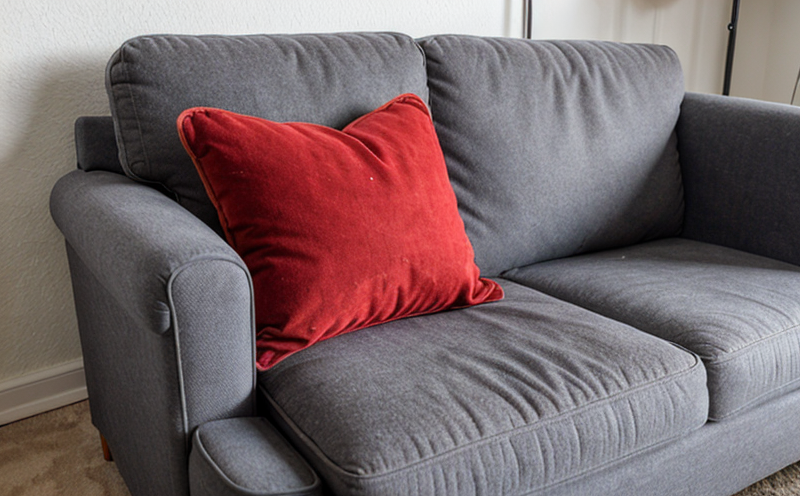ASTM E1353 Flammability Testing of Upholstered Cushions and Furniture Components
The ASTM E1353 standard is crucial in ensuring the fire safety compliance of upholstered cushions, chair backs, seat pads, and other similar components used in furniture. This test evaluates the flammability characteristics by measuring the flame spread across a horizontal specimen under controlled conditions.
Flammability tests are essential for several reasons, including consumer protection against fires caused by ignitable materials, compliance with building codes and fire safety regulations, and meeting insurance requirements that mandate fire-resistant materials. The test is conducted in a specially designed chamber that simulates real-world exposure to ignition sources like cigarettes or matches.
The specimen, typically cut from the cushion material, is placed on a metal grid within the chamber. Ignition is initiated by introducing an open flame for a brief duration (usually 15 seconds), and then the fire is extinguished. The test measures both the time it takes for the fire to spread beyond the initial ignition area and the extent of damage caused.
The standard provides detailed instructions on specimen preparation, testing procedures, and data interpretation. Specimens must be conditioned in a controlled atmosphere to ensure accurate measurements. After conditioning, they are cut into specified dimensions and mounted according to ASTM E1353 guidelines. The apparatus used for this test includes a flammability tester that ensures consistent flame exposure.
The results of the test provide critical insights into the fire performance characteristics of the cushion materials. These results help manufacturers make informed decisions about material selection, design modifications, and quality control measures to enhance product safety. Compliance with ASTM E1353 is often a requirement for furniture sold in markets that prioritize fire safety.
Understanding the importance of this testing allows stakeholders like quality managers, compliance officers, R&D engineers, and procurement professionals to appreciate its role in ensuring consumer safety and regulatory adherence. By integrating this test into their product development lifecycle, they can significantly reduce risks associated with flammable materials used in furniture.
Applied Standards
The ASTM E1353 standard is widely recognized for its stringent requirements on flammability testing of upholstered cushions and similar components. This standard aligns with other international standards such as ISO 17680, which focuses on the fire performance of furniture components.
- ASTM E1353: Provides detailed protocols for conducting flame spread tests on upholstered cushions and chair backs using a horizontal specimen method.
- ISO 17680: Covers the fire performance of furniture components in terms of smoke production, heat release rate, and flame spread.
The harmonization of these standards ensures that manufacturers can meet global market demands while maintaining consistent quality. Compliance with ASTM E1353 is often a prerequisite for selling products domestically or internationally, especially in regions where stringent fire safety regulations are enforced.
International Acceptance and Recognition
The ASTM E1353 standard has gained significant acceptance and recognition worldwide. It is widely adopted by furniture manufacturers, retailers, and regulatory bodies across various countries including the United States, Canada, Europe, and Australia.
In the U.S., compliance with ASTM standards such as E1353 is often a requirement for products sold in states like California, which has some of the strictest fire safety regulations globally. Similar requirements apply to other markets where consumer protection against fires is paramount.
The standard’s acceptance extends beyond national boundaries; it is also recognized by international organizations and regulatory bodies that oversee product safety across multiple countries. This widespread recognition underscores its importance in ensuring consistent quality and safety standards worldwide.
Use Cases and Application Examples
- New Product Development: Manufacturers use ASTM E1353 to evaluate new cushion materials before incorporating them into their product designs. This helps identify any potential flammability issues early in the development process.
- Quality Assurance: Quality control teams conduct this test regularly to ensure that all cushions meet the stringent fire safety requirements specified by ASTM E1353.
- Compliance Verification: Regulatory bodies and certification agencies use this test to verify compliance with local and international fire safety regulations.
- Risk Management: Insurance companies often require proof of compliance with ASTM E1353 as part of their underwriting process for furniture manufacturers.
- Consumer Safety: Consumers can rest assured that products meeting these standards are less likely to pose a fire hazard, thereby enhancing overall safety in homes and public spaces.
The use cases highlight the critical role ASTM E1353 plays in safeguarding consumer interests while facilitating international trade and compliance with local regulations.





